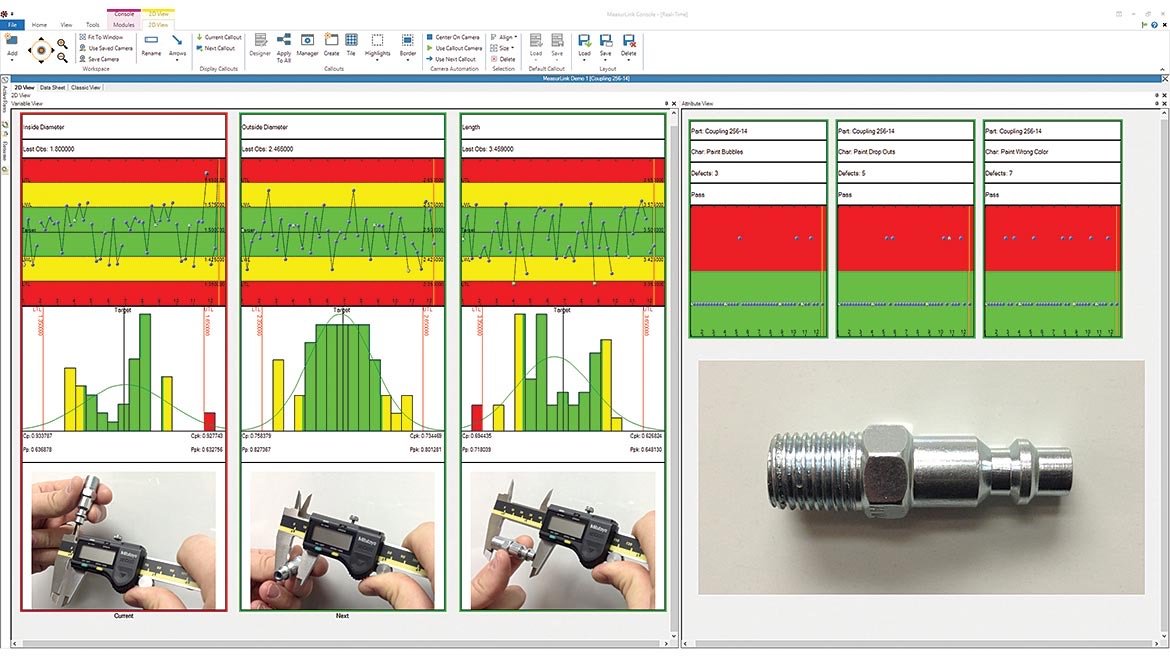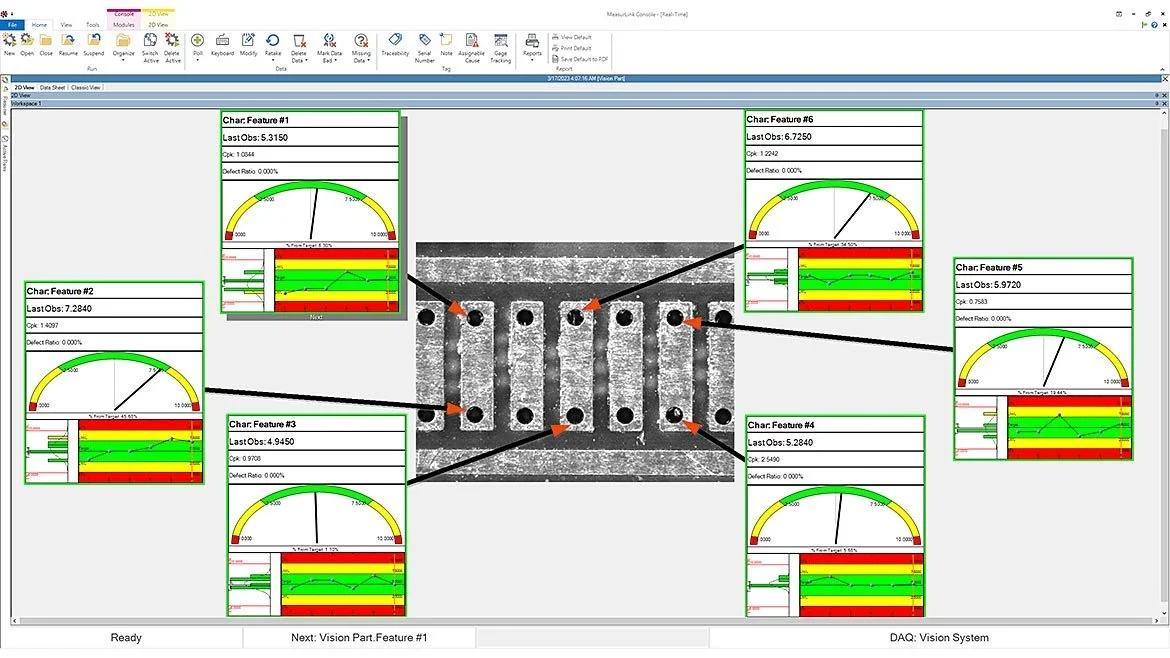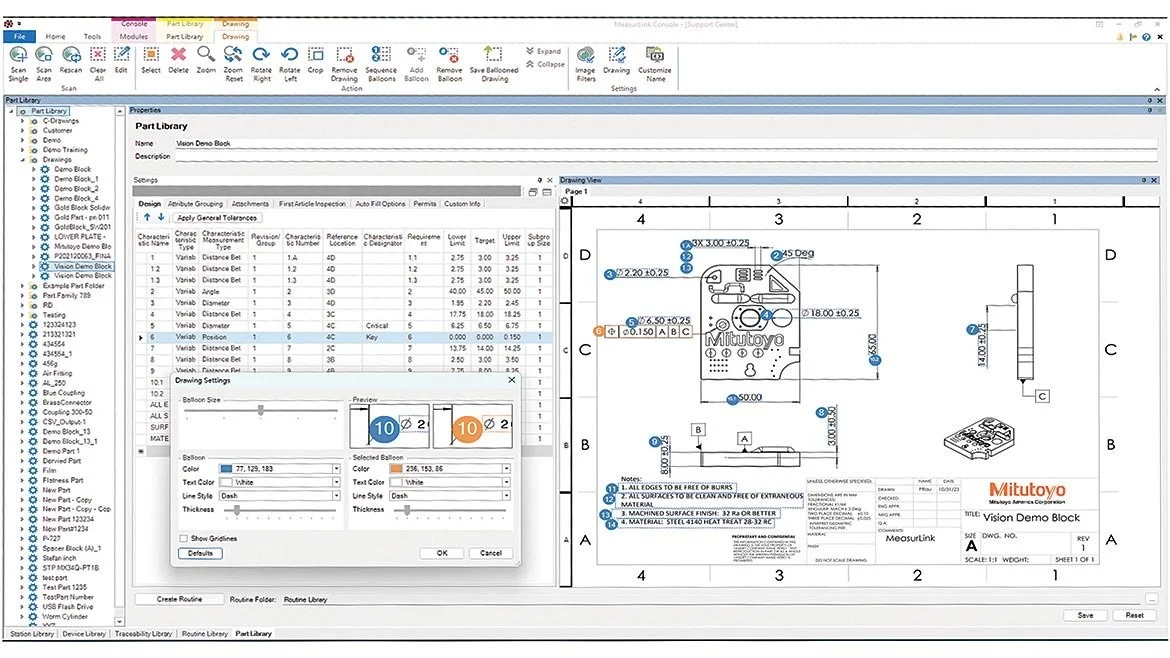Beyond the Measurement: How Data Management Software Can Transform Modern Manufacturing
A single measurement value means little without the crucial details behind it.
Real-time SPC software maximizes production while minimizing defects. Quality measurement data software that collects measurement data at the point of manufacture delivers many advantages like alerts of trends, cycles, and nonconformance of parts as soon as they occur.
When it comes to measurement data software, it’s easy to think the discussion begins and ends with raw measurement values, but it’s about much more than that. Yet many shops still see “quality data” as nothing more than a list of measurement values. In this article, we will discuss and highlight the many benefits of deploying a higher quality of measurement data software throughout your manufacturing company and show how measurement data software delivers much more than numbers.
While obtaining and managing highly accurate measurements is obviously crucial, good measurement data software collects all of the data surrounding the measurements to give a more complete picture regarding the workpiece or workpieces being measured.
This measurement data and its surrounding context is then synthesized into real-time insights and actionable items, ensuring key details of the product being measured aren’t lost in the hustle and bustle of a busy shop.
Going Beyond the Numbers
A single measurement value means little without the crucial details behind it. Think of every measurement as a story, and that story includes asking, where was the measurement taken? Who took the measurement? Under what conditions was the measurement taken? What gage was used to capture the measurement? What machine made the part?
The answers to these questions deliver traceability, which has just as big an impact on the final product as the measurement values themselves. Traceability is how you get an accurate picture of your manufacturing process with a chain of context to help pinpoint inefficiencies, prevent scrapped parts, and deliver consistent quality.
Traceability is also more than just an accounting of who took the measurement and when; it’s the backbone of a closed-loop feedback system that allows you to refine processes, troubleshoot issues, and verify compliance at any point in the production cycle. By tying each measurement to its operator, environment, and equipment calibration record, you can systematically track how each step impacts your end product and therefore take fast action when anything drifts out of tolerance.
Finally, in many industries, regulatory agencies (like the FDA for example), certification bodies, and even customers require regular audits of your manufacturing operations, processes, and final products to ensure that each part meets the necessary quality, safety, and regulatory standards. Full traceability makes these audits smoother and faster since you can produce clear, time-stamped documentation that shows exactly who did what, when, and under which conditions. This level of visibility not only ensures conformance with regulatory standards, but also fosters a culture of continuous improvement, where data-informed decisions drive better quality over time.
A real-time measurement dashboard highlights each feature’s performance and Cpk values, enabling operators and managers to quickly spot trends, prevent defects, and optimize processes. Image Source: Mitutoyo
The Real-Time Advantage: Stopping Defects in Their Tracks
Real-time data is the lifeline of modern quality control. It offers an “early warning system” that highlights production issues the moment they arise, saving your organization time, money, and the potential downstream effects of off-spec products.
Real-time measurement data collection and management, which include Statistical Process Control (or SPC), is often the difference between catching a potential defect before it leaves the shop floor and realizing too late that an entire batch of final products are out of spec.
By continuously collecting and evaluating these data points and automatically flagging trends, deviations, or other anomalies, managers and operators can identify any potential issues as they emerge. Catching these possible errors early in the manufacturing process greatly reduces the chances of your parts becoming costly scrap or needing rework. This proactive step minimizes the risk of multiple parts being produced out of spec. Instead of discovering days later that an entire batch failed to meet quality standards, real-time data lets you confine the problem to a handful of units, if there are any at all.
Why Good Software Matters
When it comes to choosing what data management software is best for your company, it’s important to know not all software is created equally. To unlock the full benefits of automated quality data, you should make sure the platforms you are looking at offer important criteria such as reliability, comprehensiveness, scalability, and maintainability.
A dependable data software platform captures and stores measurement data without any interruptions or data loss, which obviously is important. It’s essential you trust your measurement readings and record for any potential audits or compliance checks. Be sure to check if the software, and measurement system, can pass a software validation, ensuring full trust in the measurements and calculations.
Any measurement data software you use should be able to handle data from a diverse range of sources. Whatever software platform you go with should be able to manage data from small measurement tools like micrometers, indicators, and calipers all the way to more complex systems like CMMs while integrating into your existing systems. In other words, it shouldn’t matter what the tool’s make, model, or communication protocol, whether it’s wired USB, wireless Bluetooth, network ethernet cables, etc., is for the software to pull measurement data and store that information into a single centralized base.
Scalability and maintainability refer to the ability for software to evolve alongside your business. For example, if your manufacturing production demands surge and your data management software can’t handle that growth, you could end up patching together multiple databases, running out of storage capacity, or even forced to abandon the platform for a more robust one. It’s highly important to investigate a data management software solution that can adapt and be able to integrate future measuring devices.
Automated OCR ballooning links each dimension and tolerance from the print directly to real-time inspection data, ensuring faster, more accurate traceability for every measured feature. Image Source: Mitutoyo
Overcoming Implementation Hurdles
Despite all the benefits robust data management software delivers, some manufacturers are slow to change for many different reasons. Whether it’s the upfront capital investment on the software and licenses, training employees on new technology, or even IT infrastructure that is lacking, the benefits of having a quality software management system by far outweighs these drawbacks.
Manufacturing a lot of products that aren’t in tolerance, or failing an audit, can have drastic implications on your profits and working capital as well as strong legal and safety consequences. In addition to hurdles on the technical side, someone in your company will need to take ownership of your software. That could require somebody’s job duties expanding or even hiring someone dedicated to managing the data management software depending on the number of inspection stations and the amount of data collected.
Conclusion
In essence, high-quality measurement data software prevents you from flying blind. It ensures you’re not just measuring parts but capturing the context that shows you why and how parts may have deviated, who was responsible, and when corrective actions need to happen. That clarity translates directly into lower scrap rates, better operator feedback loops, and a future-proofed path to the smart factory, where automation and data analytics keep everything on track.
By gathering every detail behind your measurements and acting on that information in real time, you minimize errors, reduce downtime, give your team the power to refine processes on the fly, and be able to breeze through audits much faster and easier. Our mission is to help you harness the full potential of your measurement data so your operation can achieve consistent, high-quality output for every one of your manufactured parts.



